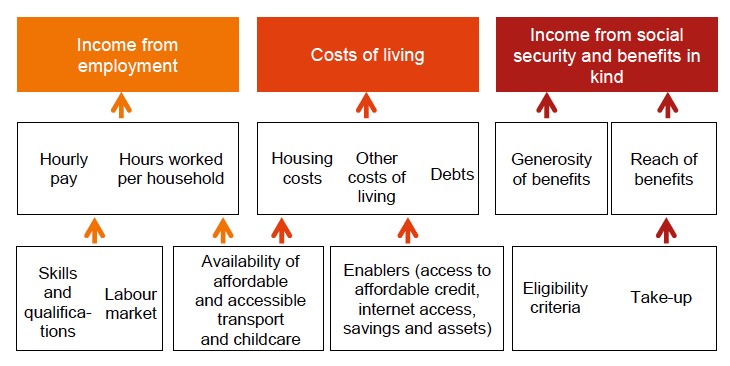Tackling child poverty delivery plan 2022-2026 - annex 6: what works - evidence review
This annex to the second tackling child poverty delivery plan 2022 to 2026 summarises the latest evidence on what works in tackling child poverty.
Child poverty targets
The aim of understanding what works in tackling child poverty revolves around Scottish Government's commitment to reach the ambitious four poverty targets, set out in the Child Poverty Act 2017.[3] The targets, to be achieved by 2030, are:
- Fewer than 10% of children living in families in relative poverty
- Fewer than 5% of children living in families in absolute poverty
- Fewer than 5% of children living in families living in combined low income and material deprivation
- Fewer than 5% of children living in families in persistent poverty.
The second Tackling Child Poverty Delivery Plan continues to address all three drivers of poverty: income from employment, costs of living and income from social security and benefits in kind. It is well documented that a combination of policies that address all three drivers is imperative to tackle poverty. Policies that aim to support incomes, either through labour market policies or through social security, will impact on all four targets. Equally important are policies that directly support families in their costs of living, which influence the combined low income and material deprivation target.

It is also important to ensure that policies are helping all families in poverty, including, and perhaps especially, those experiencing the most severe forms of poverty. Child poverty rates are perhaps most easily decreased by helping those families closest to the poverty line, who need only a relatively small increase in their income to move out of poverty. However, it is essential that we also design policies to tackle the barriers faced by families deepest in poverty, who are often facing severe and multiple forms of disadvantage and are furthest from the labour market.
Poverty affects a wide range of families with a variety of characteristics. However, we know that certain families are more likely than average to experience poverty. These are: families with a baby under one, families with three or more children, lone parent families, families with a young mother (under 25), minority ethnic families and those with a disabled family member.

These families continue to be at higher risk of poverty and future policies should continue to focus on them. When doing so, however, it is important to develop policies that take an intersectional approach and understand that families often belong to more than one priority group.[4] For example, among children in relative poverty:
- 40% of children in lone parent families also have a disabled family member
- Over half (54%) of children in a family with a younger mother are also in a lone parent family
- Half (50%) of children in families with three or more children are also in a family in which someone is disabled.
Children living in rural areas are less likely overall to be in poverty, but can face different barriers to those living in urban areas and therefore require dedicated or tailored solutions to tackle these.[5]
There is a need for an individual, holistic approach, within a framework of understanding structural barriers, in order to avoid perpetuating stereotyping and stigma.
Ideas on policies or approaches that could be taken are provided in the first findings chapter (Chapter 1).
Contact
Email: TCPU@gov.scot
There is a problem
Thanks for your feedback